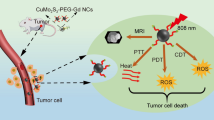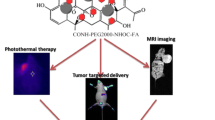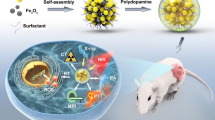Abstract
Purpose
Radiation therapy (RT) and photodynamic therapy (PDT) are promising while challenging in treating tumors. The potential radiation resistance of tumor cells and side effects to healthy tissues restrict their clinical treatment efficacy. Effective delivery of therapeutic agents to the deep tumor tissues would be available for tumor-accurate therapy and promising for the tumor therapy. Thus, developing nanoprobes with effectively delivering radiotherapy sensitizers and photosensitizers to the interior of tumors is needed for the accurate combined RT and PDT of tumor.
Methods
The size-changeable nanoprobes of Gd2O3@BSA-BSA-Ce6 (BGBC) were synthesized with a crosslinking method. Magnetic resonance imaging (MRI) and in vivo near-infrared (NIR) imaging were measured to evaluate the nanoprobes’ tumor accumulation and intratumor penetration effect. The tumor suppression effect of combined RT and PDT with these nanoprobes was also studied for the 4T1 bearing Balb/c mice.
Results
The nanoprobes BGBC showed high tumor accumulation and disintegrated into small particles responding to the photo-irradiation-produced reactive oxygen species (ROS), allowing for tumor penetration. Abundant radiotherapy sensitizers and photosensitizers were delivered to the deep tumor tissues, which is available for the accurate therapy of tumor. In addition, the BGBC displayed outstanding MRI and fluorescence imaging effects for evaluating the biodistribution and tumor suppression effect of nanoprobes. Consequently, significant tumor suppression effect was obtained based on the accurate tumor treatment with the combined RT and PDT.
Conclusion
The designed size-changeable nanoprobes BGBC showed excellent tumor accumulation and deep tumor penetration, resulting in a significant tumor suppression effect based on the combined RT and PDT. This study provides a novel strategy for dual delivery of radiotherapy sensitizers and photosensitizers into the deep tumor tissues and is promising for the accurate theranostics of tumor.






Similar content being viewed by others
References
Baskar R, Lee KA, Yeo R, et al. Cancer and radiation therapy: current advances and future directions. Int J Med Sci. 2012;9(3):193–9.
Abshire D, Lang MK. The evolution of radiation therapy in treating cancer. Semin Oncol Nurs. 2018;34(2):151–7.
Kayali M, Jaoude JA, Mohammed M, et al. Post-mastectomy radiation therapy in Triple-negative beast cancer patients: Analysis of the BEATRICE Trial. Ann Surg Oncol. 2022;29(1):460–6.
Gensheimer MF, Loo BW Jr. Optimal radiation therapy for small cell lung cancer. Curr Treat Options Oncol. 2017;18(4):21.
Babaei M, Ganjalikhani M. The potential effectiveness of nanoparticles as radio sensitizers for radiotherapy. Bioimpacts. 2014;4(1):15–20.
Kim ES, Choi JY, Hwang SJ, Bae IH. Hypermethylation of miR-205-5p by IR governs aggressiveness and metastasis via regulating bcl-w and src. Mol Ther Nucleic Acids. 2019;14:450–64.
Yadav P, Shankar BS. Radio resistance in breast cancer cells is mediated through TGF-β signalling, hybrid epithelial-mesenchymal phenotype and cancer stem cells. Biomed Pharmacother. 2019;111:119–30.
Herrera FG, Bourhis J, Coukos G. Radiotherapy combination opportunities leveraging immunity for the next oncology practice. CA Cancer J Clin. 2017;67(1):65–85.
Schaue D, McBride WH. Opportunities and challenges of radiotherapy for treating cancer. Nat Rev Clin Oncol. 2015;12(9):527–40.
Baumann M, Krause M, Overgaard J, Debus J, et al. Radiation oncology in the era of precision medicine. Nat Rev Cancer. 2016;16(4):234–49.
Connell PP, Hellman S. Advances in radiotherapy and implications for the next century: a historical perspective. Cancer Res. 2009;69(2):383–92.
Hernandez-Rivera M, Kumar I, Cho SY, et al. High-performance hybrid bismuth-carbon nanotube based contrast agent for X-ray CT imaging. ACS Appl Mater Interfaces. 2017;9(7):5709–16.
Popovtzer A, Mizrachi A, et al. Actively targeted gold nanoparticles as novel radiosensitizer agents: an in vivo head and neck cancer model. Nanoscale. 2016;8(5):2678–85.
Jeremic B, Aguerri AR, Filipovic N. Radiosensitization by gold nanoparticles. Clin Transl Oncol. 2013;15(8):593–601.
Ma NN, Wu FG, Zhang XD, et al. Shape-dependent radiosensitization effect of gold nanostructures in cancer radiotherapy: comparison of gold nanoparticles, nanospikes, and nanorods. ACS Appl Mater Interfaces. 2017;9(15):13037–48.
Li MF, Zhao Q, Yi X, et al. Au@MnS@ZnS Core/shell/shell nanoparticles for magnetic resonance imaging and enhanced cancer radiation therapy. ACS Appl Mater Interfaces. 2016;8(15):9557–64.
Rosa S, Connolly C, Schettino G, et al. Biological mechanisms of gold nanoparticle radiosensitization. Cancer Nanotechnol. 2017;8(1):2.
Detappe A, Kunjachan S, Rottmann J, Robar J, et al. AGuIX nanoparticles as a promising platform for image-guided radiation therapy. Cancer Nanotechnol. 2015;6(1):4.
Sancey L, Kotb S, Truillet C, Appaix F, et al. Long-term in vivo clearance of gadolinium-based AGuIX nanoparticles and their biocompatibility after systemic injection. ACS Nano. 2015;9(3):2477–88.
Lee C, Liu X, Zhang W, Duncan MA, et al. Ultrasmall Gd@Cdots as a radiosensitizing agent for non-small cell lung cancer. Nanoscale. 2021;13(20):9252–63.
Sun WJ, L Li, Feng YS, et al. Gadolinium–Rose bengal coordination polymer nanodots for MR-/Fluorescence-Image-Guided radiation and photodynamic therapy. Adv Mater. 2020;32(23):e2000377.
Wang F, Wen LY, Liu J, et al. Albumin nanocomposites with MnO2/Gd2O3 motifs for precise MR imaging of acute myocardial infarction in rabbit models. Biomaterials. 2020;230:119614.
Hao TN, Chen QX, Qi Y, et al. Biomineralized Gd2O3@HSA nanoparticles as a versatile platform for dual-modal imaging and chemo-phototherapy-synergized tumor ablation. Adv Healthc Mater. 2019;8(24):e1901005.
Yang GB, Phua SZF, Lim WQ, et al. A hypoxia-responsive albumin-based nanosystem for deep tumor penetration and excellent therapeutic efficacy. Adv Mater. 2019;31(25):e1901513.
Detappe A, Lux F, Tillement O. Pushing radiation therapy limitations with theranostic nanoparticles. Nanomedicine (Lond). 2016;11(9):997–9.
Huang KY, Ma HL, Liu J, et al. Size-dependent localization and penetration of ultrasmall gold nanoparticles in cancer cells, multicellular spheroids, and tumors in vivo. ACS Nano. 2012;6(5):4483–93.
Gu XF, Shen C, Li H, et al. X-ray induced photodynamic therapy (PDT) with a mitochondria-targeted liposome delivery system. J Nanobiotechnol. 2020;18(1):87.
Liu JJ, Yang Y, Zhu WW, et al. Nanoscale metal-organic frameworks for combined photodynamic & radiation therapy in cancer treatment. Biomaterials. 2016;97:1–9.
Xie JP, Zheng YG, Ying JY. Protein-directed synthesis of highly fluorescent gold nanoclusters. J Am Chem Soc. 2009;131(3):888–9.
Shen X, Liu XY, Li TT, et al. Recent advancements in serum albumin-based nanovehicles toward potential cancer diagnosis and therapy. Front Chem. 2021;9:746646.
Binandeh M, Karimi F, Rostamnia S, et al. Superior performance of magnetic nanoparticles for entrapment and fixation of bovine serum albumin in-vitro. Ethiop J Health Sci. 2020;30(4):599–606.
Hao LQ, Zhou Q, Piao Y, Zhou ZX, et al. Albumin-binding prodrugs via reversible iminoboronate forming nanoparticles for cancer drug delivery. J Control Release. 2021;330:362–71.
Ding CF, Xu YJ, Zhao YN, et al. Fabrication of BSA@AuNC-Based nanostructures for cell fluoresce imaging and target drug delivery. ACS Appl Mater Interfaces. 2018;10(10):8947–54.
Li ZW, Yang F, Wu D, Liu YH, et al. Ce6-Conjugated and polydopamine-coated gold nanostars with enhanced photoacoustic imaging and photothermal/photodynamic therapy to inhibit lung metastasis of breast cancer. Nanoscale. 2020;12(43):22173–84.
Shi XD, Yang WT, Ma Q, Lu Y, et al. Hemogobin-mediated biomimetic synthesis of paramagnetic O2-evolving theranostic nanoprobes for MR imaging-guided enhanced photodynamic therapy of tumor. Theranostics. 2020;10(25):11607–21.
American National Standards Institute. American national standard for the safe use of lasers, ANSI Z136.1-2014.
Chen MH, Chen MH, Li CY, et al. Using Gold-nanorod-filled mesoporous silica nanobeads for enhanced radiotherapy of oral squamous carcinoma. Nanomaterials (Basel). 2021;11(9):2235.
Guo XX, Guo ZH, Lu JS, et al. All-purpose nanostrategy based on dose deposition enhancement, cell cycle arrest, DNA damage, and ROS production as prostate cancer radiosensitizer for potential clinical translation. Nanoscale. 2021;13(34):14525–37.
Xu Y, Ji X, Li X, et al. URI1 suppresses irradiation-induced reactive oxygen species (ROS) by activating autophagy in hepatocellular carcinoma cells. Int J Biol Sci. 2021;17(12):3091–103.
Chen MH, Liu TY, Chen YC, Chen MH. Combining augmented radiotherapy and immunotherapy through a nano-gold and bacterial outer-membrane vesicle complex for the treatment of glioblastoma. Nanomaterials (Basel). 2021;11(7):1661.
Guo XH, Yu HZ, Shen WJ, et al. Synthesis and biological evaluation of NO-donor containing photosensitizers to induce ferroptosis of cancer cells. Bioorg Chem. 2021;116:105355.
Montaseri H, Kruger CA, Abrahamse H. Targeted photodynamic therapy using alloyed nanoparticle-conjugated 5-aminolevulinic acid for breast cancer. Pharmaceutics. 2021;13(9):1375.
Jiang QY, Pan M, Hu JL, et al. Regulation of redox balance using a biocompatible nanoplatform enhances phototherapy efficacy and suppresses tumor metastasis. Chem Sci. 2020;12(1):148–57.
Funding
This work was funded by China’s National Natural Science Foundation (NSFC, No. 92059202, 82172010, 81830053).
Author information
Authors and Affiliations
Corresponding authors
Ethics declarations
Ethical approval
All animal testing was approved by the Laboratory Animal Management Committee of Southeast University (China).
Informed consent
Informed consent was obtained from all individual participants included in the study.
Conflict of interest
The authors declare no competing interests.
Additional information
Publisher's note
Springer Nature remains neutral with regard to jurisdictional claims in published maps and institutional affiliations.
This article is part of the Topical Collection on Theragnostic
Supplementary Information
Below is the link to the electronic supplementary material.
Rights and permissions
About this article
Cite this article
Hou, Z., Zhou, M., Ma, Y. et al. Size-changeable nanoprobes for the combined radiotherapy and photodynamic therapy of tumor. Eur J Nucl Med Mol Imaging 49, 2655–2667 (2022). https://doi.org/10.1007/s00259-022-05830-9
Received:
Accepted:
Published:
Issue Date:
DOI: https://doi.org/10.1007/s00259-022-05830-9




